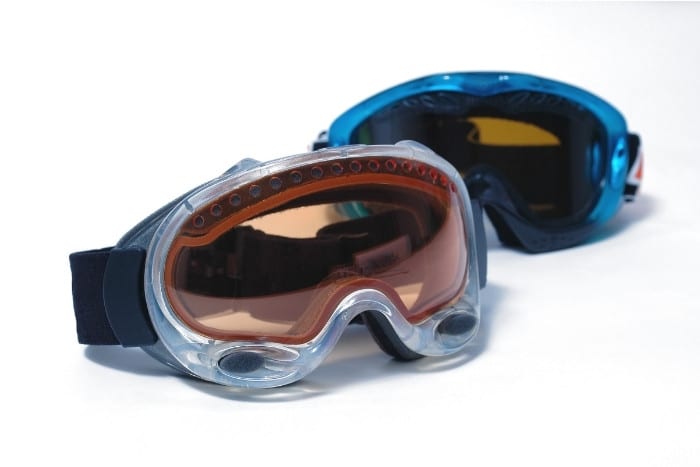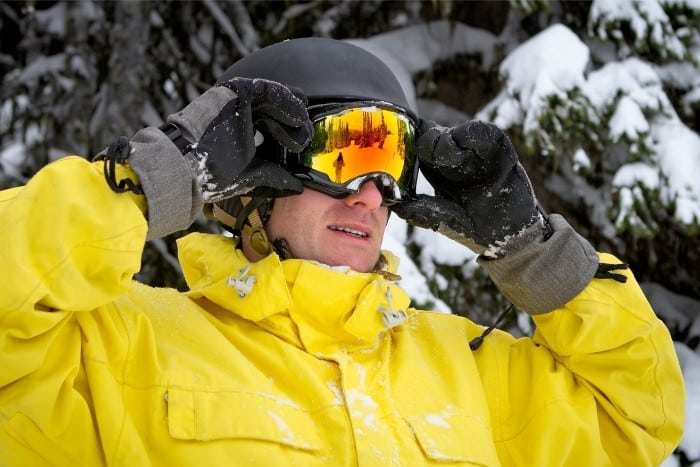Snowboarding and skiing goggles are essential pieces of gear for keeping you comfortable for your day on the hill. You may be wondering what differences they hold from one another.
Snowboarding and skiing goggles are very similar pieces of gear, being largely interchangeable with one another. There are no significant distinctions between them; many brands make goggles for skiers and snowboarders alike. However, there may be some differences in their exterior appearance.
Below, we detail the differences between the two types of eyewear.
What Is The Difference Between Snowboarding and Skiing Goggles?
Snowboarding and skiing goggles hold no significant differences and are essentially the same types of goggles. They’re primarily interchangeable, with the only differences being minor in the design choices that go into their appearance, which may vary based on skiers versus snowboarders.
1. Distinctive Factors of Goggles
Snowboarding goggles are designed with comfort in mind, as they aim to keep the wind and cold out of your eyes.
They also work with the rest of your gear as another form of insulation.
They create a seal around your head that aims to trap heat inside, to warm you up, and shelter you from the elements.
The insulating factor of snowboarding goggles works well to help keep the heat in and shield you from outside materials such as snow and ice when riding down the hill.
They function well as an additional layer of protection to help guard you against cold-related injuries like hypothermia or frostbite.
They work well for beginners and professionals alike, as they will likely stay on your face no matter what kind of snowboarding you enjoy.
However, they do have a tendency to fog up due to the increased insulation, as the seal traps heat in, causing a potential for fog to accumulate.
Some snowboarding goggles try to combat this by increasing the amount of ventilation around their design.

2. Design Elements of Goggles
When looking at snowboarding goggles, you’ll find that they’re much thicker than sunglasses in their frames.
This is a deliberate measure as snowboarding goggles aim to provide protection from the elements, such as snow or a rogue tree branch.
Snowboarding frames come in many sizes, including sizes for children, small, medium, large, and extra-large, allowing everyone to make use of their protection.
Different Types of Lenses
There are also a wide array of lenses that you’re able to choose for your snowboarding goggles, depending on your specific lighting needs.
Most goggles come with interchangeable lenses that are made to be swapped out with one another.
They are swapped out with photochromic lenses, which change the tint of the outside world, allowing you to have lenses that are adjustable based on the lighting conditions on the mountain.
This helps you to be able to see better in a variety of weather conditions, including cloudy and low light conditions.
Most goggles come with an additional lens for low light conditions, which is yellow in color, which helps increase the contrast of the snow on low visibility days.
In addition, some goggles come with polarized lenses, which help block out the sun’s harmful rays, reducing glare and the impact on your eyes.
These are typically much more expensive than other types of lenses due to the technology that goes into constructing them.
They’re very useful for sunny days on the slopes, as they are a solid barrier against the ultraviolet light that rebounds off the snow as you shred down the mountain’s slopes.
Using Skiing Goggles for Snowboarding
1. Can You Wear Skiing Goggles for Snowboarding?
You can wear skiing goggles for snowboarding. The two types of goggles are interchangeable and hold no significant differences beyond appearance.
They’re only distinct in how they get marketed, with the safety and comfort aspects of their construction being essentially the same across both types.
You’ll often find riders wearing one or the other when they’re on the slopes, as they’re not too different to where it will matter or make it unsafe if you wear one instead of the other.
Other brands market their goggles to both snowboarders and skiers. This also means that you can wear snowboarding goggles for skiing.
2. Is There a Difference in How You Should Wear Snowboarding and Skiing Goggles?
There is no difference in how you should wear snowboarding and skiing goggles.
All goggles should be worn to protect you from the elements and keep you comfortable while riding.
Most goggles are designed to be worn both underneath and over the top of helmets.
If you wear them over the top of your helmet, it is best to use the clip on the back of your helmet to secure the straps of the goggles and prevent them from slipping down.
If you wear them underneath, ensure they are over the top of your beanie so you can take them on and off easily.
There is no benefit to wearing them on either side of your helmet, and most riders prefer one over the other due to comfort.
If you wear no helmet, ensure that your beanie is tucked into your goggles, so your forehead is not exposed.
This will prevent your forehead from getting cold or sunburnt and ensure you’re not ridiculed for having a ‘goggle gap.’
Do You Need Goggles When You’re Snowboarding?
Goggles are an essential piece of snowboarding equipment that protects you from the various elements encountered on the hill. If you fail to wear goggles, you risk exposing yourself to harmful ultraviolet rays, wind, snow, and obstacles that could injure your eyes, such as trees.
1. UV Protection
Your eyes need protection from the sun’s ultraviolet rays, as snow is highly reflective of the sun’s light.
Falling to shield yourself from repeated exposure to ultraviolet light may result in snow blindness, which results in a sunburnt-like feeling in your eyes.
This can be extremely uncomfortable and put you at risk if you’re on the slopes, as you will likely want to close your eyes more often.
This poses a safety risk as you need your full attention directed toward riding down the hill and avoiding obstacles.
2. Wind Protection
Goggles are also needed to protect you from the wind.
As you will be riding down the slopes at high speeds on windy mountains, the wind can cause your eyes to water, which poses a safety risk.
Riding at high speeds can also cause snow to flick up and land in your eye, which is very cold and potentially risky.
Your best bet is always to wear some form of eye protection, be that snowboarding goggles or sunglasses.
Having something to shield you from the intense conditions you’ll face on the mountain is crucial for having a safe time snowboarding.

Final Thoughts
Snowboarding and skiing goggles hold no significant differences from one another, and they’re largely interchangeable, being very similar in all aspects beyond design.
As such, brands make goggles for both snowboarders and skiers alike.
Both snowboarding and skiing goggles are designed to shield you from the sun and cold, as they are made with lenses that help to block out harmful rays and insulation to keep you warm.
They also shield your eyes from any other obstacles, such as trees.
The goggles also feature interchangeable lenses that allow you to see in different light conditions and hit the mountain on low visibility days.
